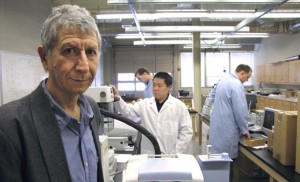Professors engaged in research do remarkable things across campus in different fields for the betterment of others.
Whether at the local, state, regional, or national level, University personnel have always used their cutting-edge expertise to make a difference.
Recently, the Department of Defense came knocking with a very specific proposal: make transportation fuels from a renewable source such as biomass to reduce its reliance on fossil fuels.
With decades of experience working with alternative fuels like corn-based ethanol, SDSU scientists were a natural fit for the project. However, making biofuels that meet military specifications from biomass requires an entirely different technology.
“The Department of Defense wants us to develop processes to make fuel from biomass that is the same, by performance standards, as petroleum-based fuels for their planes, tanks, aircraft, and other military equipment,†says Professor Jim Doolittle, director of the SDSU-based North Central Sun Grant Center.
Doolittle is project director for the study, which involves three principal investigators from three different SDSU colleges: engineering, agriculture and biological sciences, and arts and sciences.
The research proposes to produce JP-8 fuel, short for Jet Propellant 8, by using lignin from prairie cordgrass, a native North America species, and to show that a bio-based JP-8 fuel can meet the chemical/physical standards of petroleum.
Lab ranks with best
Biofuels research has been in the forefront nationwide for several decades, but Professor Alex Moutsoglou in the Department of Mechanical Engineering feels SDSU scientists have become competitive in a short period of time.
A major factor in achieving success has been the evolution of the department’s high-tech laboratory specifically devoted to the project.
“We’ve developed a state-of-the-art laboratory that would compete to the level of other labs that have been out there for a long period of time,†says Moutsoglou.
A thermochemical conversion process referred to as fast pyrolysis involves the quick heating of biomass to 500 to 600 degrees Celsius in the absence of oxygen for 20 to 30 seconds and the subsequent cooling to condense the released vapors that results in bio-oil.
Moutsoglou explains that the bio-oil produced from the pyrolysis process is not stable and ages due to its oxygen content and thus cannot be used as a transportation fuel unless it is upgraded.
“Our main emphasis is to reduce the cost of converting biomass into usable transportation fuels,†points out Moutsoglou. “We intend to achieve this in part by starting with a biomass product that contains less oxygen. For that we are using lignin extracted from prairie cordgrass.
“In addition, we are looking into using catalysts during the pyrolysis process that will improve the quality of the oil and minimize post-processing costs.â€
Prairie cordgrass has been studied extensively at SDSU as a potential bioenergy crop because of its ability to thrive in marginal soils that are unsuitable for conventional crop cultivation.
Keeping funds alive
According to Moutsoglou, catalysts hold the key. The use of catalysts during the pyrolysis process along with the introduction of hydrogen can improve the quality of the pyrolysis vapors before condensation.
“Recent results in our laboratory using zeolite catalysts have been very promising and we hope that we will be able to attract future funding to continue our ongoing research,†he notes.
The project was originally envisioned as a four-year, $16 million effort as part of an earmark in federal legislation by South Dakota’s delegation in Congress in 2009. However, due to budget cuts, funding was lost after two years.
Ultimately, Moutsoglou indicates that developing transportation fuels from biomass will become a cost-effective reality and it hinges on the development of low-cost catalysts that are easy to regenerate.
“It’s going to take a collaborative effort, and I believe it’s something that will happen not too long from now,†he says.
Kyle Johnson







